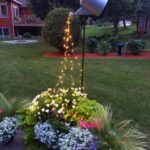Designing vegetable garden layout is crucial for a bountiful harvest. The arrangement of your vegetables influences their growth and productivity. In this article, we will explore the significance of having a well-thought-out layout for your vegetable garden and provide expert tips on how to design an effective space.
When it comes to creating a successful vegetable garden, the layout is key. You want to make sure that you are maximizing the use of your available space while also taking into account important factors such as sunlight exposure, drainage, and soil quality. By designing your vegetable garden layout strategically, you can create an environment that promotes healthy plant growth and ultimately results in a more abundant harvest.
Assessing your space to determine the best area for your vegetable garden is the first step in the process. This involves evaluating the conditions of your outdoor area such as available sunlight, water drainage, and soil quality. Once you have considered these factors, you can then move on to selecting the right vegetables for your specific climate and soil conditions. The goal is to choose crops that will thrive in your particular environment while also aligning with your personal preferences.
Assessing Your Space
When it comes to designing a vegetable garden layout, assessing your space is a crucial first step. By determining the available area for your garden and considering factors such as sunlight, drainage, and soil quality, you can set yourself up for a successful harvest. Here are some key points to consider when assessing your space:
1. Available area: Measure the space where you intend to plant your vegetables. Consider any obstacles or limitations that may affect the layout of your garden, such as trees, structures, or uneven terrain.
2. Sunlight: Take note of how much sunlight your garden receives throughout the day. Most vegetables require at least 6 hours of direct sunlight, so choose a location that provides adequate light for your plants.
3. Drainage and soil quality: Assess the drainage patterns in your chosen area to ensure that it does not become waterlogged or flooded during periods of heavy rain. Additionally, conduct a soil test to determine its pH level and nutrient content, as different vegetables thrive in different soil conditions.
Once you have carefully assessed your space and considered these factors, you will be better equipped to plan and design an effective vegetable garden layout that maximizes both space and plant health. By taking the time to evaluate these aspects of your gardening environment, you can create an ideal growing space for a bountiful harvest while minimizing potential issues with poor drainage or inadequate sunlight exposure.
Choosing the Right Vegetables
When it comes to designing a successful vegetable garden layout, selecting the right vegetables is crucial. Your choice of vegetables should be based on several factors including your climate, soil quality, and personal preferences. By considering these factors, you can ensure that your vegetable garden will thrive and yield a bountiful harvest.
Climate Considerations
Before choosing which vegetables to grow in your garden, it’s important to take into account your local climate. Different vegetables have specific temperature and growing requirements, so it’s essential to select varieties that are well-suited to your region. For example, heat-tolerant plants like tomatoes, peppers, and eggplants are better suited for warmer climates, while cool-weather crops such as lettuce, kale, and broccoli thrive in cooler temperatures.
Soil Quality
The condition of your soil also plays a significant role in determining which vegetables will grow best in your garden. Some plants prefer well-drained soil with plenty of organic matter, while others may require a more acidic or alkaline pH level.
It’s important to conduct a soil test to assess the fertility and composition of your soil before choosing which vegetables to plant. Based on the results of the soil test, you can then select vegetables that are compatible with the specific characteristics of your soil.
Personal Preferences
Lastly, when choosing vegetables for your garden layout, consider your personal preferences as well as those of your family. Are there certain vegetables that you enjoy eating regularly? Do you have favorite recipes that feature specific types of produce?
By growing vegetables that you truly enjoy consuming, you’ll not only be motivated to tend to your garden but also get to savor the fruits of your labor once harvest time arrives. Additionally if you have dietary restrictions or health considerations, you may want to prioritize growing certain types of produce that cater to those needs.
Designing Your Layout
When it comes to designing the layout of your vegetable garden, there are several options to consider. Each layout has its own advantages and can be tailored to fit the needs of your space and gardening goals. Here are some popular layout options to consider:
- Raised Beds: Raised bed gardening involves creating garden beds that are elevated above ground level, usually framed with wood or other materials. This type of layout offers better control over soil quality, drainage, and can help prevent soil compaction. It is also ideal for smaller spaces and can make gardening more accessible for individuals with mobility issues.
- Traditional Rows: The traditional row layout is a classic design where vegetables are planted in long, straight rows with pathways in between. This layout is efficient for planting and harvesting larger quantities of vegetables and works well for medium to large-sized gardens.
- Square Foot Gardening: This method involves dividing the garden into square foot sections and planting different crops in each section based on recommended spacing. Square foot gardening maximizes space and makes it easier to manage different types of plants within a limited area.
Consider the pros and cons of each layout option based on your available space, time commitment, and personal preferences before deciding which one will work best for your vegetable garden. Each has its own benefits and can contribute to a successful harvest when planned effectively.
Companion Planting
Some common examples of companion planting include growing aromatic herbs such as basil and parsley near tomatoes to help improve flavor and repel pests, or planting marigolds alongside vegetables like squash and cucumbers to deter nematodes and other harmful insects. Understanding the compatibility of different plants will not only benefit their growth, but it can also enhance the overall health of your garden ecosystem.
In addition to pest management, companion planting can also help with maximizing space in your garden. For example, tall, sun-loving plants like corn can provide shade for lower-growing crops such as lettuce or spinach.
Similarly, vining plants like cucumbers or peas can be grown vertically on trellises, allowing you to make the most out of limited ground space. With careful planning and consideration for which plants work well together, companion planting can be an effective strategy for a bountiful harvest in your vegetable garden.
| Companion Plants | Benefits |
|---|---|
| Basil & Tomato | Enhanced flavor and pest repellent |
| Marigolds & Squash/Cucumbers | Deters nematodes and harmful insects |
| Corn & Lettuce/Spinach | Provides shade for lower-growing crops |
Utilizing Vertical Space
When it comes to designing a vegetable garden layout, utilizing vertical space is a key factor in maximizing your garden’s potential. Vining plants and trellised crops not only make the most of limited space, but they also promote better air circulation and sunlight exposure, leading to healthier plants and a more bountiful harvest.
One of the most popular methods for utilizing vertical space in a vegetable garden is through the use of trellises. Trellises provide support for climbing plants such as tomatoes, cucumbers, peas, beans, and squash. By training these plants to grow vertically along a trellis, you can effectively double or triple your growing area without expanding the footprint of your garden. This method also makes maintenance tasks such as watering and harvesting much easier.
Another way to make the most of your garden’s vertical space is by incorporating structures such as arbors, A-frame trellises, or cages. These can be used to support various vining plants while adding visual interest to your garden. Additionally, using hanging baskets or vertical planters can allow you to grow herbs or smaller vegetables like lettuce and strawberries in limited space areas such as patios or balconies.
Incorporating vertical gardening techniques not only optimizes your space but also helps create an aesthetically pleasing and functional vegetable garden layout. Whether you have a small urban plot or a larger rural garden, exploring different options for growing vining plants and trellised crops can significantly increase the productivity and overall appeal of your vegetable garden.
| Benefit | Example |
|---|---|
| Maximizes growing area | Growing cucumbers vertically along a trellis |
| Promotes better air circulation | Using arbors or A-frame trellises for climbing plants |
| Aesthetically pleasing | Using hanging baskets for small vegetables on a patio |
Setting Up Irrigation
Assessing Your Water Source
Before setting up an irrigation system for your vegetable garden, it’s essential to assess your water source. Determine if you will be using a hose or if you have access to a nearby water spigot. Understanding the location and availability of your water source will help you plan the layout of your irrigation system.
Options for Irrigation Systems
There are several options for irrigating your vegetable garden, including soaker hoses, drip irrigation, and overhead sprinklers. Each has its advantages and disadvantages, so it’s important to choose the one that best suits your garden’s needs. Soaker hoses, for example, deliver water directly to the base of plants, reducing evaporation and ensuring efficient use of water.
Conserving Water Through Smart Techniques
Once you have chosen an irrigation system, there are several techniques you can use to conserve water and ensure efficient watering. Consider using mulch around your plants to retain moisture in the soil and prevent water evaporation. Additionally, watering in the early morning or late evening can reduce evaporation and ensure that more water reaches the roots of your vegetables.
By carefully evaluating your water source, choosing the right irrigation system, and implementing smart techniques to conserve water, you can efficiently provide your vegetable garden with the moisture it needs for a successful harvest while minimizing waste.
Maintenance and Succession Planting
In conclusion, designing a well-thought-out vegetable garden layout is crucial for achieving a successful harvest. By carefully assessing your space, choosing the right vegetables, and implementing a strategic layout, you can maximize your garden’s potential. Additionally, incorporating companion planting, utilizing vertical space, setting up efficient irrigation, and planning for ongoing maintenance and succession planting are all essential elements in creating a productive and sustainable vegetable garden.
Ensuring ongoing care through maintenance activities such as weeding and fertilizing is vital for the health and productivity of your vegetable garden. By regularly tending to your plants and providing them with the necessary nutrients, you can promote strong growth and abundant yields.
Furthermore, planning for multiple planting seasons allows you to extend the harvest period and make the most of your garden throughout the year. Succession planting ensures a continuous supply of fresh produce by staggering the sowing and harvesting of different crops.
Incorporating these elements into your vegetable garden layout will not only contribute to a bountiful harvest but also promote sustainability and resource efficiency. By making thoughtful choices in design, plant selection, and ongoing care, you can create a thriving vegetable garden that provides an abundance of fresh, homegrown produce for you and your family.
Frequently Asked Questions
How Do I Design My Vegetable Garden Layout?
When designing your vegetable garden layout, consider the space you have available, the amount of sunlight each area receives, and the types of vegetables you want to plant. It’s important to group together plants with similar watering and sunlight needs, while also considering proper spacing between plants to allow for growth.
You may also want to consider companion planting to help deter pests or enhance growth.
What Vegetables Should Not Be Planted Next to Each Other?
Some vegetables should not be planted next to each other due to their susceptibility to similar pests or diseases. For example, tomatoes and potatoes should not be planted near each other as they are both susceptible to blight.
Similarly, beans and onions should be kept apart due to their differing soil pH requirements. Carrots and dill should also be separated as dill can attract pests that may harm carrots.
What Is the Row Layout for a Vegetable Garden?
The row layout for a vegetable garden will depend on the particular needs of your chosen vegetables and the available space. However, a common approach is using wide rows, which allows for less walking space in between rows and more space for planting.
Another option is raised bed gardening where separate beds are created for different vegetables, making it easier to maintain optimal growing conditions for each type of plant. Ultimately, the row layout will need to be tailored based on the specific needs of your chosen vegetables and your individual gardening goals.

Welcome to my gardening blog! I am passionate about plants and enjoy sharing my knowledge and experiences with others. In this blog, I will write about everything related to gardening, from tips on how to get started to updates on my own garden projects.





